
Five-spice powder is a spice mixture of five or more spices used predominantly in almost all branches of Chinese cuisine. The five flavors of the spices refers to the five traditional Chinese elements. The addition of eight other spices creates thirteen-spice powder (十三香), which is used less commonly.
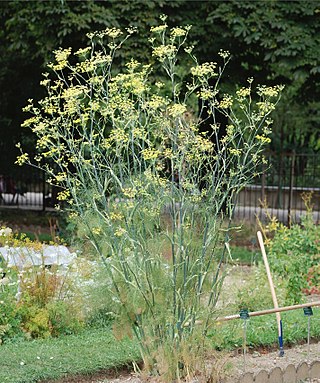
Fennel is a flowering plant species in the carrot family. It is a hardy, perennial herb with yellow flowers and feathery leaves. It is indigenous to the shores of the Mediterranean but has become widely naturalized in many parts of the world, especially on dry soils near the sea-coast and on riverbanks.

Garam masala [from Hindustani گرم مصالحہ/गरम मसाला ] is a blend of ground spices originating from India. It is common in Indian, Pakistani, Nepalese, Bangladeshi, Sri Lankan and Caribbean cuisines. It is used alone or with other seasonings.

Fenugreek is an annual plant in the family Fabaceae, with leaves consisting of three small obovate to oblong leaflets. It is cultivated worldwide as a semiarid crop. Its seeds and leaves are common ingredients in dishes from the Indian subcontinent, and have been used as a culinary ingredient since ancient times. Its use as a food ingredient in small quantities is safe.

Ajwain, ajowan, or Trachyspermum ammi—also known as ajowan caraway, omam , thymol seeds, bishop's weed, or carom—is an annual herb in the family Apiaceae. Both the leaves and the seed‑like fruit of the plant are consumed by humans. The name "bishop's weed" also is a common name for other plants. The "seed" is often confused with lovage "seed".
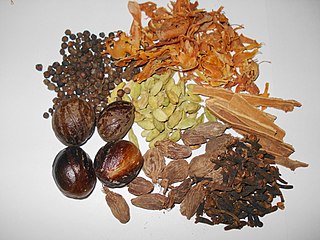
Spice mixes are blended spices or herbs. When a certain combination of herbs or spices is called for in a recipe, it is convenient to blend these ingredients beforehand. Blends such as chili powder, curry powder, herbes de Provence, garlic salt, and other seasoned salts are traditionally sold pre-made by grocers, and sometimes baking blends such as pumpkin pie spice are also available. These spice mixes are also easily made by the home cook for later use.
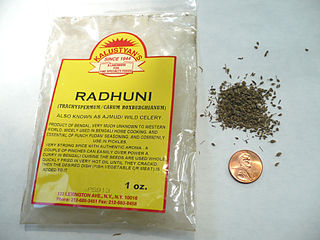
Trachyspermum roxburghianum is a flowering plant in the family Apiaceae. It is grown extensively in South Asia, Southeast Asia, and Indonesia. Its aromatic dried fruits, like those of its close relative ajwain, are often used in Bengali cuisine but are rarely used in the rest of India. The fresh leaves are used as an herb in Thailand and it is used medicinally in Myanmar and Sri Lanka.

Nigella sativa is an annual flowering plant in the family Ranunculaceae, native to eastern Europe and western Asia, but naturalized over a much wider area, including parts of Europe, northern Africa and east to Myanmar. It is used as a spice in many cuisines.

Chettinad cuisine is the cuisine of a community called the Nattukotai Chettiars, or Nagarathars, from the Chettinad region in Sivaganga district of Tamil Nadu state in India. Chettinad cuisine is perhaps the most renowned fare in the Tamil Nadu repertoire. It uses a variety of spices and the dishes are made with fresh ground masalas. Chettiars also use a variety of sun-dried meats and salted vegetables, reflecting the dry environment of the region. Most of the dishes are eaten with rice and rice based accompaniments such as dosas, appams, idiyappams, adais and idlis. The Chettiars, through their mercantile contacts with Burma, learnt to prepare a type of rice pudding made with sticky red rice. The chefs of manapatti village near Singampunari are experts in cooking Chettinad cuisine. They always used to cook in bulk orders for marriage functions, political functions, etc. though manapatti cooking is portrayed as madurai cuisine because it is located near to madurai district, it comes under chettinad cuisine only and it also comes under the chettinad region of sivagangai district. The entire village people is famous in the art of cooking.
Bhojpuri cuisine is a style of food preparation common among the Bhojpuri people of Bihar and eastern Uttar Pradesh in India, and also the Terai region of Nepal. Bhojpuri foods are mostly mild and tend to be less hot in terms of spices used. The cuisine consists of both vegetable and meat dishes.
Bihari cuisine is eaten mainly in the eastern Indian state of Bihar, as well as in the places where people originating from the state of Bihar have settled: Jharkhand, Eastern Uttar Pradesh, Bangladesh, Nepal, Mauritius, South Africa, Fiji, some cities of Pakistan, Guyana, Trinidad and Tobago, Suriname, Jamaica, and the Caribbean. Bihari cuisine includes Bhojpuri cuisine, Maithil cuisine and Magahi cuisine.

Mizrahi Jewish cuisine is an assortment of cooking traditions that developed among the Jews of the Middle East, North Africa, Asia, and Arab countries. Mizrahi Jews have also been known as Oriental Jews.
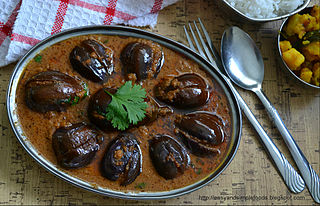
Kuḻambu, is a common dish in Tamil Nadu and Sri Lankan cuisines, and is a tamarind based dish that can include a variety of meat, vegetables, and in some cases, dal.
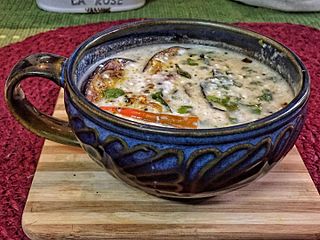
Dahi baigana is an Odia dish prepared from dahi (yogurt) and eggplant especially during festivals. This dish can be prepared without using onion and garlic when they are not allowed in some auspicious festivals.
The following outline is provided as an overview of and topical guide to herbs and spices:

Green mango chutney, also known as raw mango chutney, is an Indian chutney prepared from unripe mangoes. Ripe mangoes are sweet and are not used for chutneys as they are eaten raw. Green unripe mangoes are hard and sour, and they are cooked as chutneys. Mango chutneys are tangy in taste.
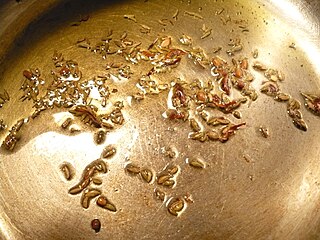
Tempering is a cooking technique used in India, Bangladesh, Nepal, Pakistan and Sri Lanka, in which whole spices are roasted briefly in oil or ghee to liberate essential oils from cells and thus enhance their flavours, before being poured, together with the oil, into a dish. Tempering is also practiced by dry-roasting whole spices in a pan before grinding the spices. Tempering is typically done at the beginning of cooking, before adding the other ingredients for a curry or similar dish, or it may be added to a dish at the end of cooking, just before serving.

Cumin is a flowering plant in the family Apiaceae, native to the Irano-Turanian Region. Its seeds – each one contained within a fruit, which is dried – are used in the cuisines of many cultures in both whole and ground form. Although cumin is used in traditional medicine, there is no high-quality evidence that it is safe or effective as a therapeutic agent.

The history of spices reach back thousands of years, dating back to the 8th century B.C. Spices are widely known to be developed and discovered in Asian civilizations. Spices have been used in a variety of antique developments for their unique qualities. There were a variety of spices that were used for common purposes across the ancient world. Different spices hold a value that can create a variety of products designed to enhance or suppress certain taste and/or sensations. Spices were also associated with certain rituals to perpetuate a superstition or fulfill a religious obligation, among other things.

Kuchela, also spelled kucheela, occasionally also kuchila, is a hot relish of the Trinidadian cuisine.


















